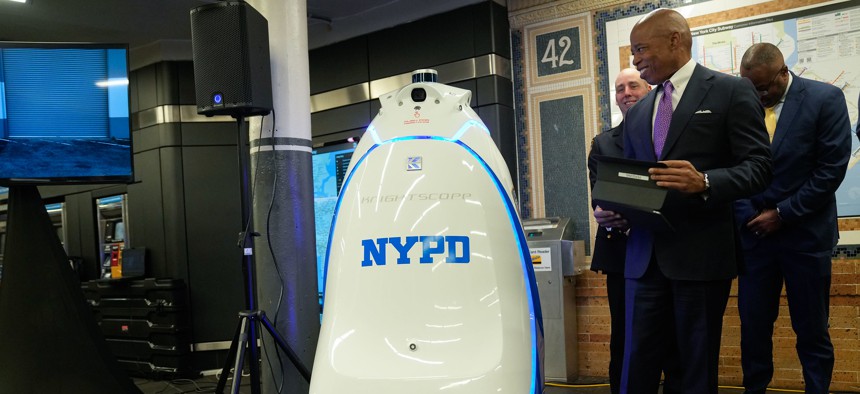Opinion
Opinion: The City Council must strengthen police transparency laws
The NYPD is exploiting loopholes in the Public Oversight of Surveillance Technology Act to shield its new spying tools from oversight.

Mayor Eric Adams introduces the new NYPD robot called K5 at the Times Square subway station on Sept. 22, 2023. Michael Appleton/Mayoral Photography Office
Unleashing surveillance technology on New Yorkers with little warning or explanation has become a habit with the NYPD. On Friday, Mayor Eric Adams unveiled a 420-pound patrol robot that will record live video in the Times Square subway station. A few weeks ago, the department deployed drones to spy on Labor Day celebrations and backyard barbecues in New York City. And in recent months, it has adopted a slew of novel surveillance tools, like GPS guns and robot dogs. But police have provided little meaningful information on how they would address privacy concerns raised by the technologies.
The NYPD is required by law to provide information about how it uses spying technology, but has consistently flouted that obligation. Now, the New York City Council has taken notice, introducing two bills (here and here) aimed at strengthening the law. These bills must be passed into law to increase transparency and protect New Yorkers from police spying.
At issue is NYPD’s failure to comply with the Public Oversight of Surveillance Technology Act (POST Act). The law was passed in 2020 amid growing evidence that the NYPD was targeting racial justice protesters and communities of color with its array of surveillance tools. It requires the police to publish policies on each of the surveillance technologies it uses, disclosing their capabilities, rules for deployment, potential impact and measures in place to ensure they won’t violate the privacy and civil liberties of New Yorkers.
But the NYPD has exploited loopholes in the law. A report last year by the department’s own inspector general documents a variety of ways in which the NYPD has evaded its obligations to the public and sought to avoid transparency. One involves grouping similar technologies together under a single broad policy rather than creating individual detailed policies for each tool, a practice the inspector general criticized as “contrary to the intent” of the POST Act. The police also fold new tools – like their recently adopted digital fingerprint scanners, dog-like surveillance robots, and augmented reality apps – into existing policies, sidestepping the POST Act’s requirement that the police submit new technologies for public review before deployment.
Another way that the NYPD gets around the POST Act is by using “general and generic” language to report critical information, including how it protects the privacy of those it surveils or under what terms it shares surveillance data with other government agencies, such as federal immigration authorities. In the case of drone footage – like that captured over Labor Day – the police baldly state in their policy for “unmanned aircraft systems” that they can share footage with outside law enforcement agencies, whoever they may be, if they adhere to “applicable laws and regulations, and NYPD policies,” whatever those may be.
Instead of reporting on the actual impact of surveillance technologies on racial and religious groups, the police simply cite “safeguards and audit protocols” in place to “mitigate the risk” of “biased law enforcement.” That’s hardly reassuring given the NYPD’s history of discriminatory surveillance, such as using license plate readers to spy on Muslim communities, placing gunshot detection technology in majority Black and Latino neighborhoods and surveilling social media for posts that are supposedly evidence of gang membership to build out the police’s racially skewed gang database.
The inspector general concluded that the NYPD’s disclosures were “insufficient” to achieve “appropriate transparency with the public” and made 15 recommendations for improvements. The NYPD rejected all but one.
But the City Council agreed with the inspector general’s recommendations and wants to make them law. One proposed bill would amend the POST Act to be more explicit in directing the NYPD to provide information, including on safeguards, for each individual surveillance technology; specifically name the external agencies with which it shares surveillance data and safeguards in place for sharing; and strengthen the requirement that the police identify potential disparate impacts of the technologies on protected groups (like racial or religious minorities). The other bill would provide the inspector general with more detailed information to allow for meaningful auditing of the department’s compliance with the law.
But there is more the City Council should do. Any bill passed should mandate reporting on the accuracy of tools such as facial recognition software, which has been demonstrated to be rife with racial bias – and require more extensive disclosures on information sharing arrangements with other agencies.
The City Council passed the POST Act in response to public demand for greater police accountability. It must now strengthen the law to ensure that the police can no longer treat it as a check-the-box exercise that fails to provide the transparency that New Yorkers deserve.
Ivey Dyson is counsel in the Liberty and National Security Program at the Brennan Center for Justice at NYU Law.
NEXT STORY: Commentary: Migrants are breaking Democratic Party unity

